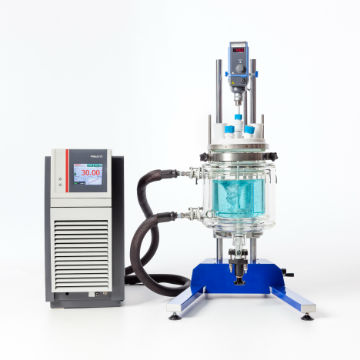How choice of reactor vessel affects reaction performance

New report compares the thermal performance and advantages of vacuum jacketed versus non-vacuum jacketed reaction vessels.
Asynt has produced a new report that compares the thermal performance and advantages of vacuum jacketed versus non-vacuum jacketed reaction vessels.
Data is presented for vacuum jacketed and non-vacuum jacketed reaction vessels connected to a Julabo Presto A30 temperature control system. The report demonstrates that a vacuum jacketed vessel not only achieved faster rates of cooling but was also able to maintain a reaction at -20 °C compared with just -15 °C for the non-vacuum jacketed vessel. Using a vacuum jacketed vessel was also shown to eliminate ice formation on the outside of the reactor glass (a common problem with non-vacuum jacketed reaction vessels), allowing continuous viewing of the reactor contents.
By reducing heat loss/gain a glass vacuum jacket enables faster rates of heating and uses less energy to cool the system, thereby enabling lower temperatures to be achieved than reactor vessels without a vacuum jacket. The report concludes that using a vacuum jacketed reaction vessel will allow users to optimise thermal performance thereby improving control of reactions. In addition, the report proposes that the small additional cost of a vacuum jacketed vessel is easily justified not only by the additional performance but also by the cost saving of being able to use a lower powered temperature control system.
Vacuum jacketed reaction vessels are available as options for the Asynt ReactoMate Pilot (5-50 L) and for the Asynt ReactoMate Datum (100 mL - 5 L) reactor systems.
Related News
-
News Patients vs Pharma – who will the Inflation Reduction Act affect the most?
The Inflation Reduction Act brought in by the Biden administration in 2022 aims to give better and more equitable access to healthcare in the USA. However, pharma companies are now concerned about the other potential costs of such legislation. -
News CPHI Podcast Series: What does the changing US Pharma market mean for industry and patients alike?
In this week's episode of the CPHI Podcast Series Lucy Chard, Digital Editor for CPHI Online is joined by James Manser to discuss the political and market changes in the US pharma field. -
News CPHI Barcelona Annual Report illuminates industry trends for 2024
The CPHI Annual Survey comes into it’s 7th year to report on the predicted trends for 2024. Over 250 pharma executives were asked 35 questions, with their answers informing the industry landscape for the next year, spanning all major pharma marke... -
News Which 10 drugs are open to price negotiation with Medicare in the USA?
The Centres for Medicare & Medicaid Services, under the Biden administration in the USA, has released a list of the 10 drugs that will be open to price negotiations as part of the new legislation under the Inflation Reduction Act (IRA). -
News EU Medical Devices Regulation causes unintended disappearances of medical devices for children, doctors state
Doctor groups and associations have appealed to the EU to correct the EU Medical Devices Regulation law that may cause unintended shortages of essential drug and medical devices for children and rare disease patients. -
News 10 Major Drug Approvals So Far in 2023
Last year, 37 novel drugs were approved by the FDA, this was a high number for such a category, and covered many fields including oncology, demonstrating how promising further research is, and how it is only continuing to build. To date, there are alre... -
News Detecting Alzheimer's disease with a simple lateral flow test
A novel rapid diagnostic test for early-stage Alzheimer's disease has been developed using a biomarker binder from Aptamer Group along with technology from Neuro-Bio, the neurodegenerative disease experts. -
News CPHI Podcast Series: outsourcing and manufacturing trends
Listen to the CPHI Podcast Series this June to hear Gil Roth of the PBOA speak with Digital Editor Lucy Chard about the biggest trends and topics to watch in pharma outsourcing and manufacturing at the minute.
Position your company at the heart of the global Pharma industry with a CPHI Online membership
-
Your products and solutions visible to thousands of visitors within the largest Pharma marketplace
-
Generate high-quality, engaged leads for your business, all year round
-
Promote your business as the industry’s thought-leader by hosting your reports, brochures and videos within your profile
-
Your company’s profile boosted at all participating CPHI events
-
An easy-to-use platform with a detailed dashboard showing your leads and performance







